When you want to relax under the stars there’s no better way than on your back looking up at the zenith. We explore what’s overhead and discover there’s more than one zenith up there.
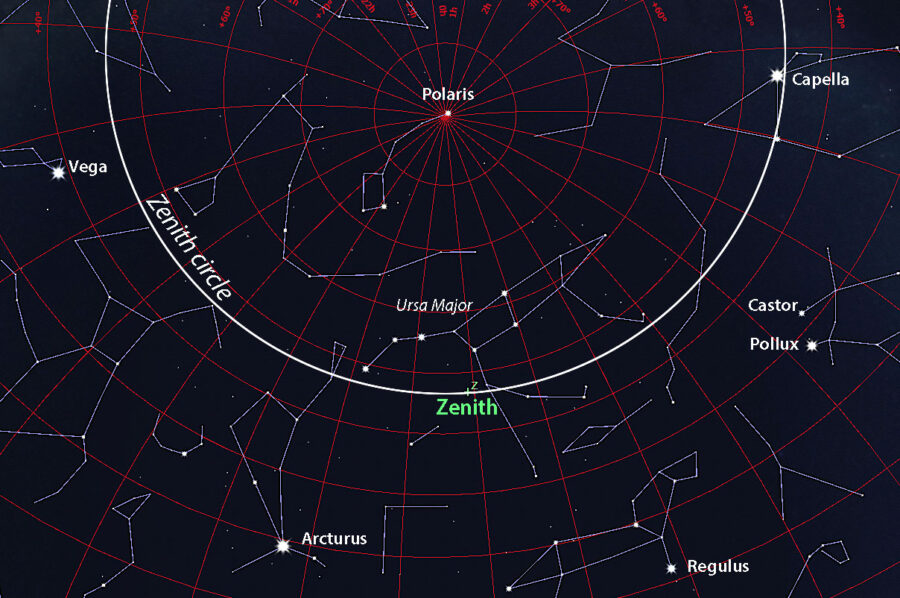
Stellarium with additions by Bob King
Observing is a pain in the neck. Standing and staring up at the sky for long periods of time isn't natural. But thanks to two mind-blasting auroral storms this past March and April I rediscovered the joy of horizontal stargazing. Tired of standing and pivoting about, I finally sprawled out on the dirt road and faced the zenith. What a revelation. The new perspective made me dizzy at first. My entire visual field was nothing but sky and quivering aurora. Without an earthly frame of reference I felt totally exposed, but it allowed me to completely surrender to the frenetic activity above.
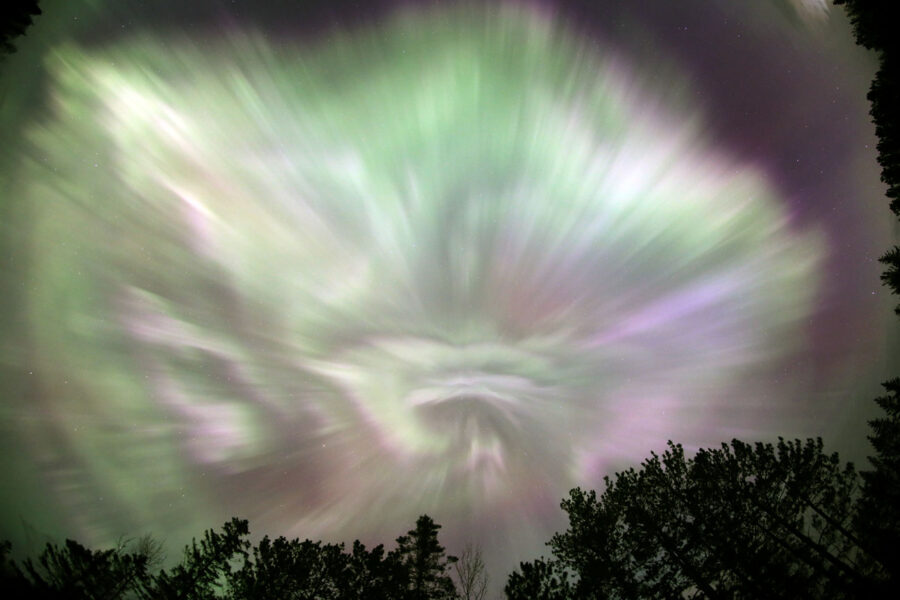
Bob King
I folded my hands on my chest and quietly quaked with awe. Lying down also makes one feel smaller and more vulnerable, a perspective further enhanced by the vastness of the cosmic dome above. This is a good sensation, one many observers consider one of the best reasons to be involved in astronomy. Such revelatory moments often arrive unexpectedly making them that much sweeter and more intense.
To the summit!
At the time I remember noticing that the seven stars of the Big Dipper occupied the overhead spot. That got me thinking about other notable stars and deep-sky objects that pass through or close to my local zenith including Capella, Deneb, and the Andromeda Galaxy. If you'd like to get acquainted with your own zenith stars you need just two numbers — your latitude and the object's declination. Any star with a declination equal to your latitude passes through your local zenith. To find a favorite star's declination go to the Simbad site and type its name into the Identifier box. Click enter or Submit ID and the ICRS line will show its precise position. Or just simulate the night sky with a planetarium-style software program like Stellarium (from the left-hand menu select Sky and View options / Markings / Zenith and Nadir) or use the interactive map on the Stellarium website and click on the Azimuthal Grid from the menu at bottom.
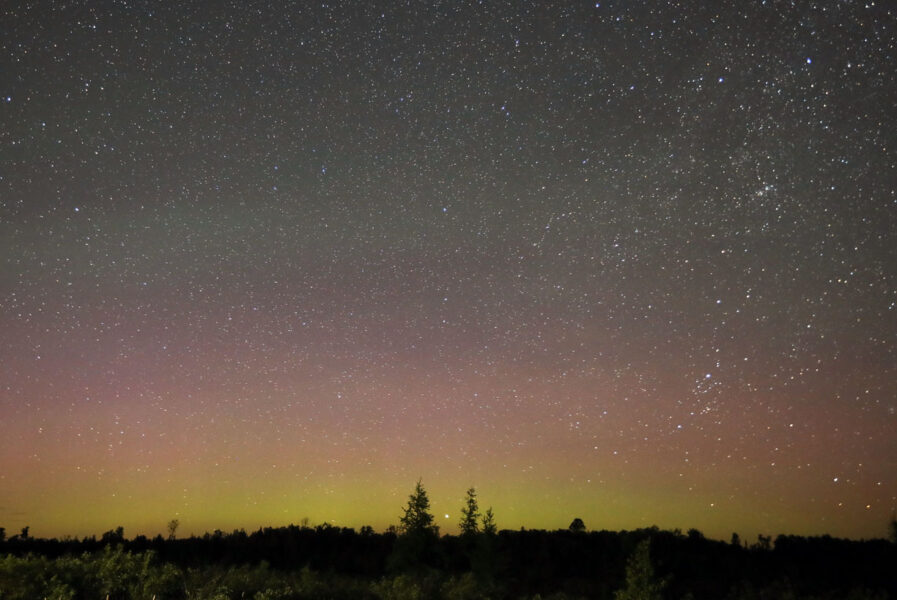
Bob King
For example, the bright wintertime star Capella's declination is +46.0° (46° north of the celestial equator). I live at latitude 47° north , so Capella passes just 1° south of my zenith, making it the brightest star that passes overhead at my latitude. Conversely, Capella is also the brightest star visible closest to the nadir, the point in the sky directly opposite the zenith. It appears just 3° high directly beneath the Pole Star at its lower culmination. I tell students in my community astronomy classes that the same star twinkling at the bottom of the sky during summer twilights will shine overhead on frigid February nights. Deneb is another near-zenith star with a declination of +45.3° (1.7° south of my zenith).
Zenithal celebs
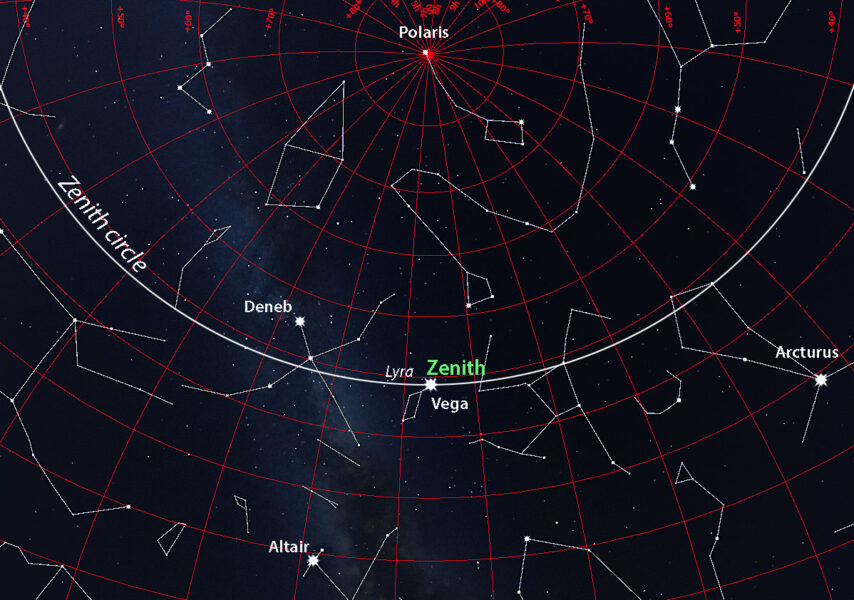
Stellarium with additions by Bob King
While parts of the Great Bear (Ursa Major) exactly cross the zenith at my location none of the Dipper stars do. The southernmost of them, Alkaid, has a declination of +49.3° and pivots at the zenith for skywatchers in Vancouver, British Columbia (49.2°N). In Mexico City (19.4°N) , radiant Arcturus misses the zenith by only a couple tenths of a degree. As Arcturus is one of my all-time favorites I'm a little jealous. Maybe I should plan zenith vacations to experience some of these simple yet satisfying sights. In New Orleans (30°N) the Gemini twins Castor and Pollux straddle the overhead point, looking observers right in the eyes. Kansas City, Missouri (39.1°N), claims Vega while Bolivia's capital La Paz (16.5°S) hosts Sirius, the brightest nighttime star of all.
If you're wondering about the Southern Cross (Crux) and the brilliant duo of Alpha and Beta Centauri, they're overhead from Elephant Island, Antarctica (61.1°S). The crew of the Endurance Trans Antarctica Expedition, led by polar explorer Ernest Shackleton, was stranded on the island for 4 ½ months in 1916 from April 24th through August 29th as they waited for Shackleton to seek help for a rescue attempt. During the long polar nights the men would have seen them wheel overhead. Perhaps their bright presence gave hope.
Everyday, non-catastrophic extinction
The zenith is special for another reason. Looking straight up, we see through the least amount of air. Celestial objects are brightest when viewed overhead. Every degree aslant of the zenith increases the degree of atmospheric absorption and further dims celestial objects. Venus commands the western sky this spring with a current magnitude of about –4.2. In early dusk, when its elevation stands around 30°, it's a few tenths of a magnitude fainter compared to a zenith view. But by the time it reaches the horizon it plummets to magnitude 1.0 — more than 100 times fainter! The amount of air directly overhead equals one airmass by definition and dims a star by about 0.16 magnitude depending on elevation and air quality. At the horizon we peer through 40 airmasses where the air, water vapor, dust, and aerosols exact a major toll.
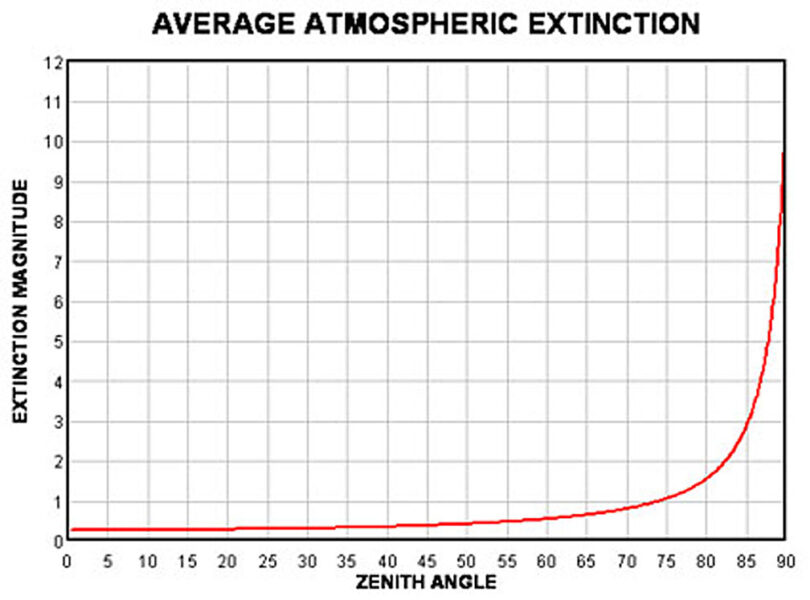
Casey Reed Asterism.org
If we could remove the atmosphere, zenithal stars would appear ever-so-slightly brighter. The biggest difference would be that the entire sky from the horizon up would appear as dark as the zenith and not a single star would twinkle. That's how I imagine skywatching from the Moon, where you'd see every star rise at full brilliance untainted by extinction. Perhaps a bigger shock would be the glacierlike movement of the stars. Because the Moon rotates about 28 times more slowly than Earth, a star on the celestial equator there takes about two hours to climb 1° compared to four minutes on Earth.
True vs. magnetic zenith
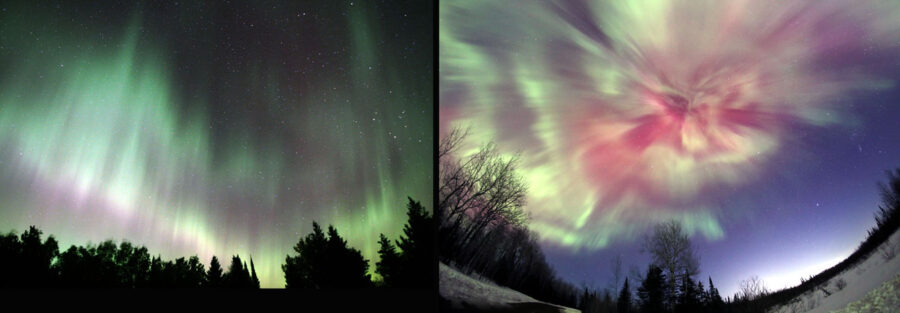
Bob King
I mentioned the aurora earlier. In northern Minnesota we've witnessed spectacular auroras this season that displayed every form imaginable. When at its peak, multiple shafts of light — formed when high-speed electrons excite atmospheric oxygen and nitrogen atoms 100–200 kilometers overhead — cartwheeled around a point high in the southern sky known as the magnetic zenith (MZ). Although auroral rays are essentially parallel they appear to converge at this point due to perspective and create the corona aurora. A similar effect occurs with crepuscular rays (otherwise known as sunbeams) that appear to radiate from the Sun or Moon.

Source: Karla Panchuk (2018) CC BY-SA 4.0, modified after Steven Earle (2015) CC BY-SA 4.0, and T. Stein (2008) CC BY-SA 3.0
The magnetic zenith only gives itself away when the sky is awash with northern lights during coronal displays and marks the direction of the local magnetic field. Facing the MZ we look directly up the magnetic field lines wrapping around the planet. It's an important place for visual observers because it greatly affects the appearance of the aurora. The top of an auroral ray seen exactly at the MZ looks like a spot or segment because we peer upwards to its vanishing point. Yet the same ray viewed only a few degrees from the MZ assumes the form of a long, pointed beam. When multiple parallel rays hang from the MZ they create a stunning starburst pattern. You'll see a similar effect from the downtown of a major city when you look up and tall buildings appear to converge in the sky above.
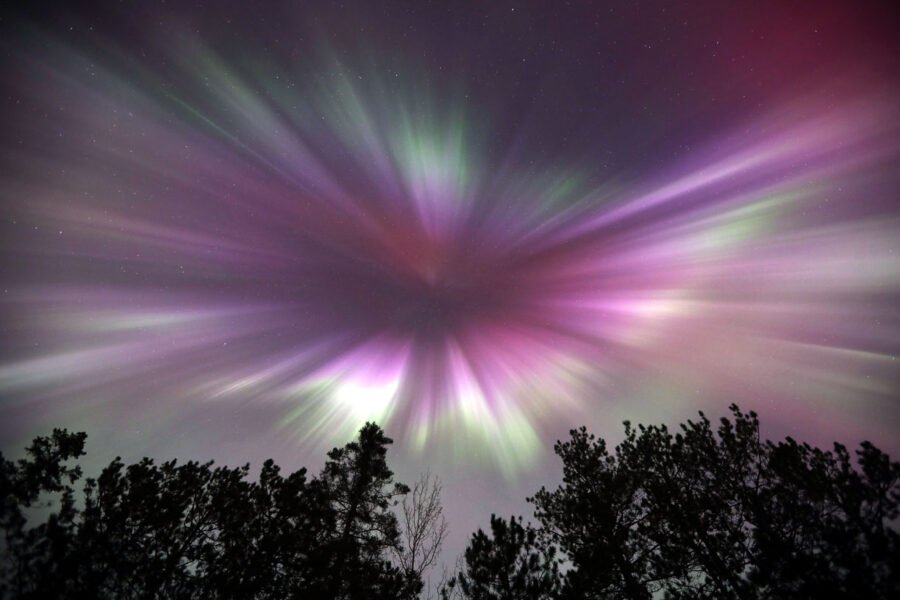
Bob King
At the magnetic north pole, currently located in the Arctic Ocean at latitude 86.1° north, 146.4° east, the tip of a dip needle surveying compass would point straight down (90° from the horizontal). The other end of the compass would point straight up to the magnetic zenith (MZ), which coincides with the familiar zenith.
At the magnetic south pole the needle points straight up, while at the the magnetic equator it's horizontal. In the contiguous U.S. it inclines from 53° at Key West to 73.5° near the North Dakota-Canadian border. The inclination angle defines the altitude of the local magnetic zenith. For Key West that point stands at 53° altitude or 37° south of the true zenith. For Grand Forks, North Dakota, the MZ climbs to 73° altitude or 17° south of overhead. Remember we're talking about magnetic inclination, the up-down component of Earth's magnetic field. Magnetic declination is the deviation of the compass needle from true north.
You can determine your local magnetic zenith (MZ) or coronal pivot point at magnetic zenith.com. Either use the search function or zoom into the map to find your city. Click it and note the inclination value. In Minneapolis the inclination is 71°, placing the magnetic zenith high in the southern sky 19° (90°–71°) from the zenith.
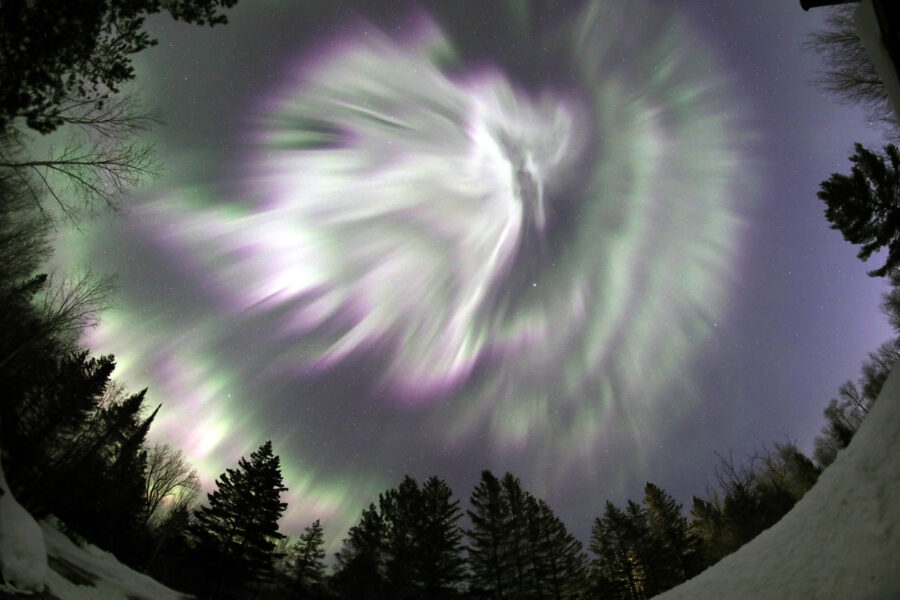
Bob King
No matter how you take your zenithal experience, whether straight up or aslant with a twist of corona, I hope you'll enjoy getting horizontal under the starry sky soon.
 9
9









Comments
Yaron Sheffer
May 11, 2023 at 8:53 am
Hi Bob, a great article (literally!)
At times, when lying on my back watching nothing but sky, I get the feeling that I'm looking down, and it's only my planet's gravity that's keeping me from falling into empty space...
Me thinking you have misapplied the term Nadir. All sources say it's the exact opposite of Zenith, thus it cannot be applied to locations near the horizon.
And while star watching on the Moon would be breathtaking (ha!) down to the horizon, you would lose seeing your favorite auroras (aurorae?)...
You must be logged in to post a comment.
Bob KingPost Author
May 11, 2023 at 10:38 am
Hi Yaron,
Thank you! And that so true about the Moon. Observing there would be breathtaking but without auroras and other atmospheric phenomena that make the sky so interesting day and night. Guess you can't have everything 🙂 Thank you for pointing out my error regarding the nadir. I defined it correctly in the article but misused the term. Capella gets very close to the nadir.
You must be logged in to post a comment.
Yaron Sheffer
May 13, 2023 at 11:24 pm
Bob, you use the formula (90 minus magnetic inclination) to compute the altitude, yet the result seems to be ZD, zenith distance. Isn't the altitude (above the horizon) given by the inclination already?
You must be logged in to post a comment.
Bob KingPost Author
May 14, 2023 at 8:12 pm
Hi Yaron,
Huh! You're right. My method gives the zenith angle — which is correct — but it requires a subtraction, so it's clearly the long way around. I think I did this because I wanted to put everything in the context of the true zenith. Magnetic inclination = the altitude of the magnetic zenith. Why of course it does. Brilliant! Thank you 🙂
You must be logged in to post a comment.
Anthony Barreiro
May 11, 2023 at 5:01 pm
Thank you Bob. Magnetic zenith is a new concept for me.
Lying back looking straight up, with or without binoculars, is truly luxurious. If you want to observe stars or planets near the zenith through a telescope, use an equatorial mount. Altazimuth mounts have to do gymnastics to track near the zenith.
You must be logged in to post a comment.
Bob KingPost Author
May 11, 2023 at 9:05 pm
Anthony,
Yes, that's a nice way to describe it. I'll bunch up an extra sweater for a makeshift pillow. True about the zenith — if something's up there I want to see and I'm using a Dob I take a deep breath.
You must be logged in to post a comment.
ToomasKarmo
May 12, 2023 at 4:39 pm
Thanks for wonderfully instructive article, particularly as regards the observer's local magnetic zenith. - Some day it might be good to have from Sky and Telescope a further discussion of geomagnetism, supplementing the figure whose caption contains the sentence "Currents flowing within Earth's molten outer core create a planet-wide magnetic field that acts like a bar magnet with north and south magnetic poles." If interpreted naively, that figure, as it now stands, may lead some readers with overactive visual imaginations to think (a) that Earth literally has a dipole magnetic field, geometrically like the field of a magnetized straight steel rod, and consequently (b) that at any point on Earth's surface, a compass needle points to Earth's north magnetic pole (i.e., points to the location whose coordinates have in recent years or decades been approximately 86oN, 164oE). A helpful supplementary figure would correct the potential misapprehension "(b)", by making it clear that the horizontal (compass-needle-indicated, as opposed to dip-needle-indicated) component of Earth's magnetic field has a sinuous or spatially meandering or repeated-S-curve aspect, thanks both (i) to irregularities in the flow of conductive liquid material far below Earth's crust and (ii) to local mineralogical inhomogeneities, such as the presence of hematite deposits, in the crust. All one can really say about the relation of the compass needle to the north magnetic pole is that if one faithfully walks at each instant in the direction in which one's compass needle is at that instant pointing, one eventually, after repeated divagations or meanderings or S-curves to right and left, arrives at the north magnetic pole. (One does NOT, in other words, follow a tidy great-circle geodesic trajectory to the north magnetic pole.) In such a supplementary treatment, it might arguably be worth remarking also that when one arrives at the north magnetic pole, one's local magnetic zenith coincides with one's local astronomical zenith, and that while one's compass now gives no meaningful reading, one's dip needle now points to one's local astronomical nadir, and that these remarks would continue being true even if - contrary to fact - Earth's magnetic field had the simple geometry of a true dipole (magnetized straight steel rod) magnetic field.
You must be logged in to post a comment.
Bob KingPost Author
May 12, 2023 at 5:10 pm
Dear Toomas,
Oh, how I wanted to go into more depth about much of what you described. Unfortunately, my zenith-focused article wasn't the place. I did indeed include a mention of the overlap of magnetic and local zenith at the magnetic poles, but the other aspects of Earth's fascinating and complicated magnetic field would make a wonderful future story. I greatly appreciate the suggestion!
You must be logged in to post a comment.
Anthony Barreiro
May 12, 2023 at 10:00 pm
Toomas, you've already written a good pitch for your article. Send it to the editor! Don't forget to mention that Edmond Halley, when he wasn't calculating comet orbits, measured and theorized about the geomagnetic field.
You must be logged in to post a comment.
You must be logged in to post a comment.